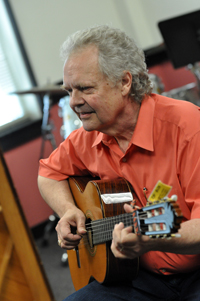"I'm kind of the oddball. I'm here because a lot of people are curious about this technique, fingerstyle. I show them how to take melodies on the guitar—solo line melodies—and play those melodies while playing the chords at the same time. You're trying to get two layers going. You're using mostly your thumb just to play the lower notes of the chord while the fingers pick out the melody notes on the upper strings. The fingerpickers do that in such a way that the thumb is alternating back and forth on the string, being the rhythm as well. So I'm not just playing the chord under the note, I'm recreating a beat: boom-chick, boom-chick, boom-chick."
"I teach guitar arranging for songwriters and the Chet Atkins advanced skills lab. I have the historical examples that I consider important, and say right out at the first class, 'This is the evolution of fingerstyle,' and I'll play them a dozen examples that we're going to work from for the rest of the semester and I'm sort of taking the temperature of the class to see which ones their ears perk up on. You can develop these right-hand techniques with a fairly wide selection of music."
"[Chet Atkins and I] became friends because I could do something he couldn't do, which was this whole stride guitar idea and he got really into it. And you can watch his playing begin to change. The closest he could come to accommodating it was instead of just hearing the thumb hit one note all the time for the four beats, you can—in his later recordings—hear his thumb coming forward and having his fingers joining it in the middle strings to play an entire chord, which is part of what I was doing, my little contribution to the history."
"You need your thinking and your playing speeds to just about match. And that's hard. For ear training I tell them, 'Take your finger and put it on any junction of string and fret anywhere on the graph that is your fingerboard.' And then I say, 'Alright, now play "Happy Birthday" from that note and use your own ears and try to listen ahead, try not to play a wrong note.' You have to look down at the fingerboard and imagine what the next spot sounds like while youre playing. It's like a huge game of concentration. If you do a tune a day at the end of this month you will have done 31 tunes. And you will be on your way. You do any puzzle 31 times and you begin to find the solutions."
"Learning to finger pick with the thumb moving back and forth is essentially the same thing as riding a bicycle. I can tell you all about the bicycle, we can look at the wheels and gears and we can stand next to one for a while and talk about what it's like but sooner or later you are going to have to get on that bicycle. And you're only going to be as good a rider as the amount of time you spend on it. I can't come up with a better metaphor than that. You just keep falling off the bike trying to learn these patterns and then suddenly you don't fall off anymore. Also like a bicycle, once you really learn how to do it, it's one of these things you don't ever forget. It's a muscle memory kind of thing. It'll stay with you from then on."

